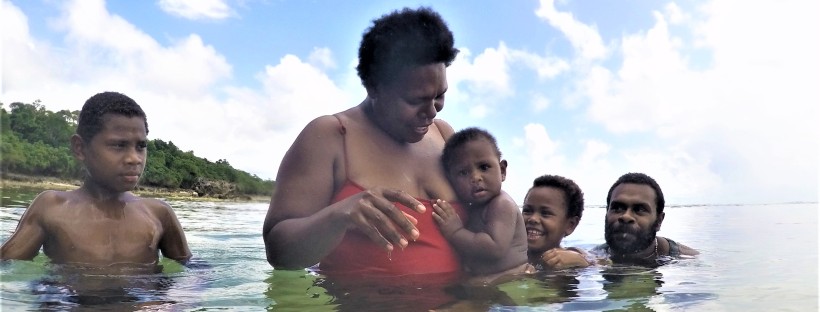The world lost a sweet, innocent soul last week. I heard the news through a series of Facebook messages sent to me by my host family and Undra’s father, Willy (this is the only way we communicate, now). Baby Undra had gotten sick last week and tragically succumbed to her illness on January 7th, 2020 at the Port Vila Central Hospital.
You may remember last year’s post about little Sasa, who died of a heart condition on January 1st, 2019. With Undra’s passing, Marae has lost two babies just one year apart. That’s two too many.
My heart breaks for my community from afar, but mostly, my heart breaks for Saima and Willy, Undra’s parents. They taught me so much, loved me like their own, included me in everything, and took care of me in a very special way during my time in Marae. They were my best friends, and like my second host family.
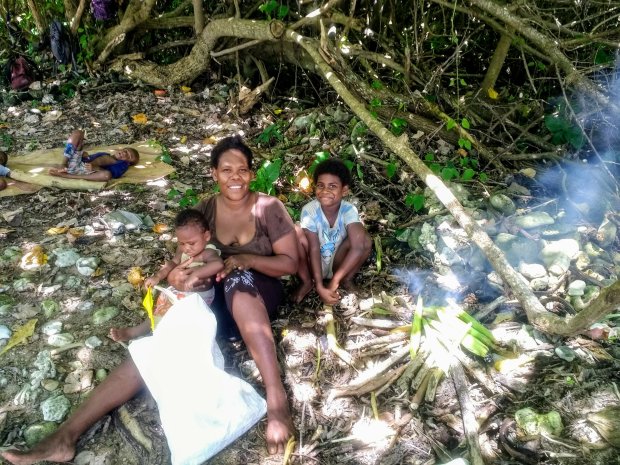
Roasting corn on Good Friday, 2019
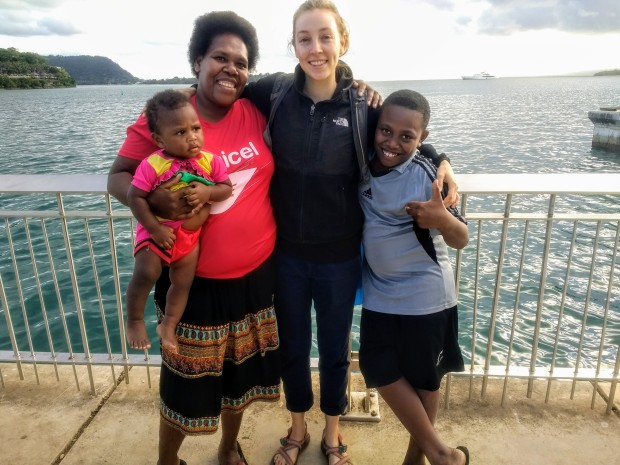
Saying goodbye to Saima, Undra, and Richard before leaving Vanuatu.
And now, they have just buried their baby daughter.
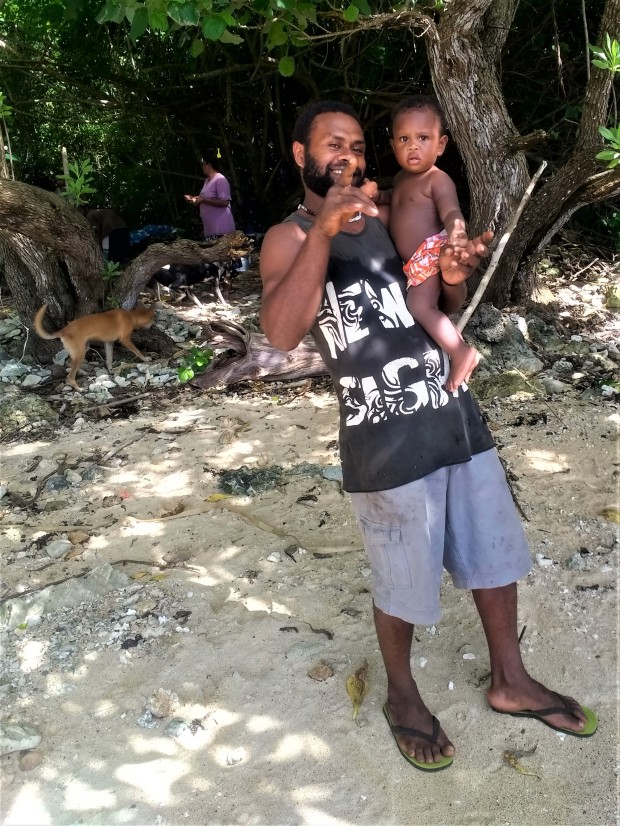
Willy and Undra, Easter 2019
It’s a strange feeling being away from my community in times of tragedy. One I can’t quite describe. I can picture the exact events that unfolded leading up to Undra’s death, and ultimately, her funeral and burial. I can picture these events exactly because I witnessed far too many funerals in my two short years as a Peace Corps Volunteer, and because I understand the ins and outs of Emae’s culture and customs like the back of my hand. The image I have conjured is solidified, even justified, through the pictures sent to me after the funeral (Fair warning: the following photos may be difficult to look at), and through a rare conversation I was lucky enough to have with Willy just a few days after Undra’s death.
I can picture the first couple of days that Undra began showing signs of an illness. Her mother carrying her down to the Aid Post and asking Dorah for some medicine. Dorah prescribing her something mild. Maybe some Panadol. Maybe some children’s aspirin or cough syrup. She gives Saima some Oral Rehydration Salts (ORS) to help keep Undra hydrated.
I can picture Saima carrying Undra back to their home, the last home in the village before entering an endless jungle. I can picture Saima’s mother, Leipakoa, mixing up some sort of custom, medicinal leaf to feed her granddaughter, or to rub on her weak body. Saima, preparing a cool bath infused with mandarin leaves for her baby in the hopes of reducing her fever, then laying her down on a freshly woven pandanus mat to feel the salty breeze. Rinny, holding and comforting her baby sister.
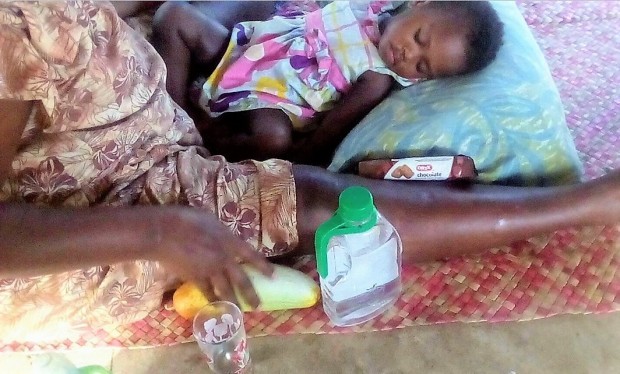
Undra sick, before going to Vila. Sent by Willy.
I can picture Saima waking up the next morning only to find Undra weak and feverish, lethargic, no appetite. The medicine’s not working. She begins to panic now. Dorah makes a house call, then refers them to the island’s only Health Center. They arrive by truck and Donald, the area nurse, takes a look. They sleep overnight in one of the Health Center’s empty rooms, fielding visitors who’ve heard the news and have walked several miles just to say a prayer for Undra. In the morning, there’s no change. They sleep another night. Again, no change.
They begin to panic now. Donald makes arrangements for Saima, Willy, and Undra to go to Port Vila. Undra needs the hospital… Now.
Perhaps they took a 3-hour boat ride over rough, open ocean to reach the Vila wharf. Maybe they boarded the 9-hour overnight ship. Most likely, they took a 1-hour, bumpy truck ride to the airport where they waited in a dilapidated concrete building filled with cow manure for a few hours before boarding the 6-seater plane.
I can picture Cina, Saima’s sister, picking them up at the airport, holding Undra in her arms, kissing her and whispering, “Oh, bebe blo mi…” (Oh, my baby). They drive to the hospital where they wait in a crowded waiting room for too long.
I can picture Undra being brought to a modest hospital room. They lay her down on a rusty bed covered by clean white sheets. A nurse takes her temperature. Perhaps they hook her up to an IV to get some fluids into her dehydrated body. Saima sits vigil at her bedside while Willy paces the room. Cina calls home to update the rest of the family.
A few days pass, and nothing changes. The doctors can’t seem to break her fever. She won’t eat or drink anything. She can’t move. They’ve seen this far too often – babies brought to the hospital too late. Too late to make a difference.
I can picture the doctors pulling Saima and Willy aside, telling them that they’ve done all they can for their daughter, but there’s nothing more that can be done. The fever has already done too much damage. If only they’d brought her in sooner. If only…. The doctor informs the pair that their daughter will die soon, then gives the parents time to sit with their grief.
I can picture Saima taking Willy’s hand as they cry tears of grief together. Cina joins them, and they send up one last prayer for the daughter and niece they love so much. Saima returns to her baby’s bedside to lie beside her, preparing herself for the fact that she will lose her daughter in a matter of days? Hours? Minutes?
I can picture the moment Undra takes her last breath at the Vila Central Hospital. I can hear the wailing ensue from her hospital room. It’s not the customary wailing you’d hear at a funeral, but the true and honest cries of grief-stricken parents who just lost their child. Others join in to express their condolences.
I can picture Saima and Cina dressing Undra’s lifeless body in her nicest Sunday island dress. Something white, and lacy, and elegant enough to send this sweet baby off to Heaven. They purchase new calico to line her coffin and grave. They gently place her delicate frame in a wooden coffin just big enough to fit a not-yet 2-year-old child.
I cannot know exactly how Saima and Willy feel in this moment. I hope I will never know such pain. But I can picture them going through the motions, numb to the world around them. Numb, as the airport attendants screw the lid on their daughter’s coffin. Numb, as they gingerly slide her wooden home into the back of the plane. Numb, as they board the plane and prepare to bring their baby home to her final resting place.
I can picture my community prepping for her arrival. They have lined Saima and Willy’s veranda with calico. They have sprinkled baby powder on the ground and the children have collected an array of tropical flowers to lay beside Undra’s body. The men have already decided who will dig her small grave, and a truck has already been sent to the airport to await the arrival of the charter plane. The back of the truck is weighed down with family and friends who will greet Saima, Willy, Cina, and Undra at the airport to share in their grief with the bone-chilling cries I remember so well.
I can picture the charter plane making its rocky landing on the overgrown, grassy runway. The plane speeds to a stop as mud, morning dew, and cow manure splatter the sides of the plane. The pilot brings the plane to a stop in front of the airport, just in time for Undra’s family to rush out onto the grassy field, embrace Saima and Willy, and wail.
I can picture Eddy, the local airport agent, carefully sliding Undra’s coffin out from the back of the plane then passing it off to Willy. He delicately balances the eerily light box on one shoulder as Poland, his brother, takes the other end. Everyone follows behind, stroking the coffin and wailing. The women use small strips of ripped calico to wipe their eyes and shoo away flies.
I can picture them lining the truck bed with colorful calico, then placing Undra’s coffin on top as everyone piles in. The truck winds its way through the sandy jungle road, leaving a trail of dust and heartbreak as it goes.
I can picture the run-down truck breaking through the overgrowth to enter Marae, passing the tourist bungalows, the Aid Post, and the Community Hall. It heads straight for the end of the village. Almost everyone in the community is there waiting to help unload the coffin and join together in their shared grief. The rest will come soon enough when the wailing intensifies, joined by members of nearby villages.
The truck has arrived and in a flash, Undra’s coffin is removed and placed in the center of the veranda on a bed of flowers and calico. She is immediately swarmed by masses of people who drape their bodies over her wooden coffin, heaving heavily under the burden of their cries.
I can picture Saima making her way through the crowd, kids moving aside to allow a grieving mother access to her child. She drops to her knees and sprawls out over the lid of the coffin as dozens of arms reach out to embrace her. Willy stands to the side, wiping away his tears, head hung low.
One of the men comes forward with a drill to unscrew the lid of the coffin. He lifts the lid to reveal Undra’s still body. If you look past the pea-sized cotton balls stuffed in her nostrils, she almost looks peaceful, as if only sleeping. If only it were so. The wailing intensifies now, and will only cease when the Pastor of the Presbyterian Church begins the communal prayer. Perhaps the children have prepared a song or two for Undra, just as they did for Sasa only a year before.
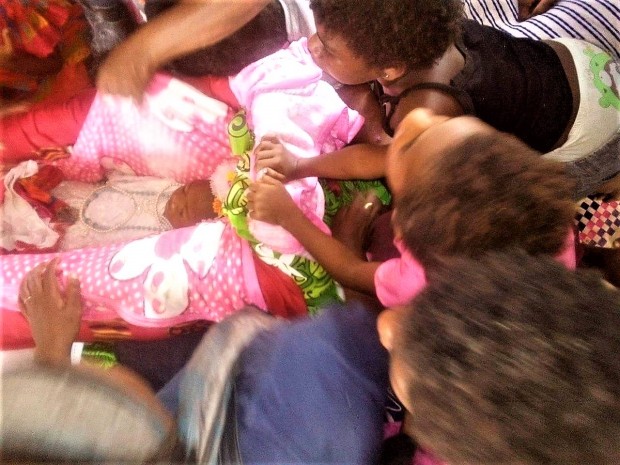
Undra in her coffin during the wailing ceremony. Sent by my host papa.
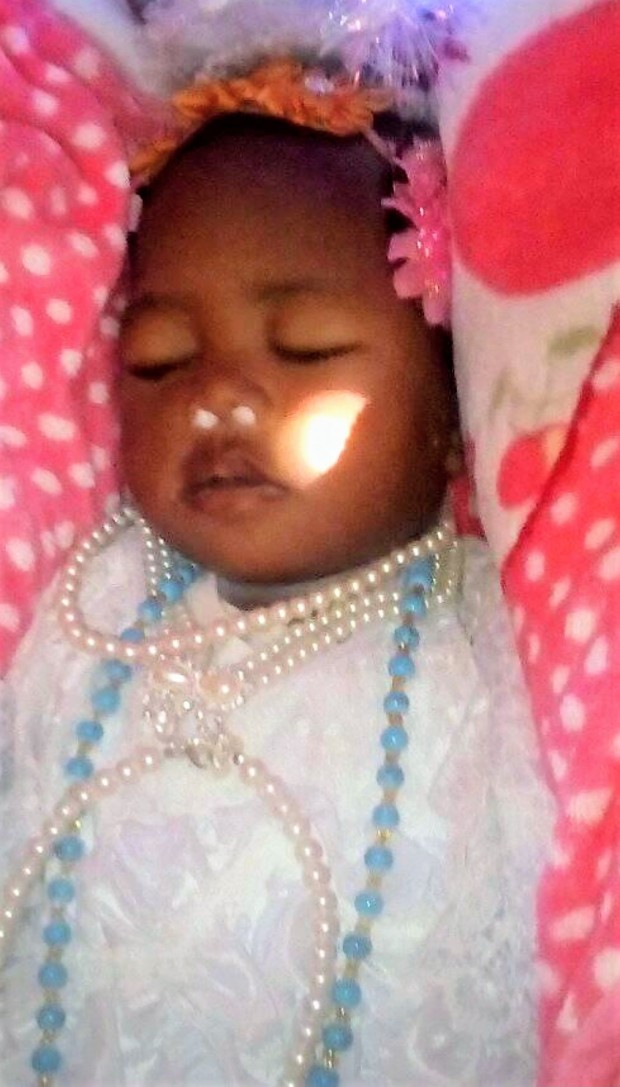
Undra dressed in her Sunday best. Sent by Willy. Cotton keeps fluids from leaking out… 😦
And after the funeral, I can picture my community preparing to carry Undra’s body to the cemetery. Saima will give her baby one last kiss right before the lid is returned, forever encasing the child in the darkness of her calico-lined coffin. 5-year-old Doraline holds Saima’s hand as the little sister she’s always wanted is carried off to her final resting place. A trail of people follow, and everyone gathers around her small grave.
It has been decorated beautifully. Each of her four dirt walls are lined with purple and white calico, accentuated by her many island dresses dangling from the opening of her grave. A red, Winnie The Pooh blanket is laid on the dirt floor to make Undra’s new home a little more inviting.
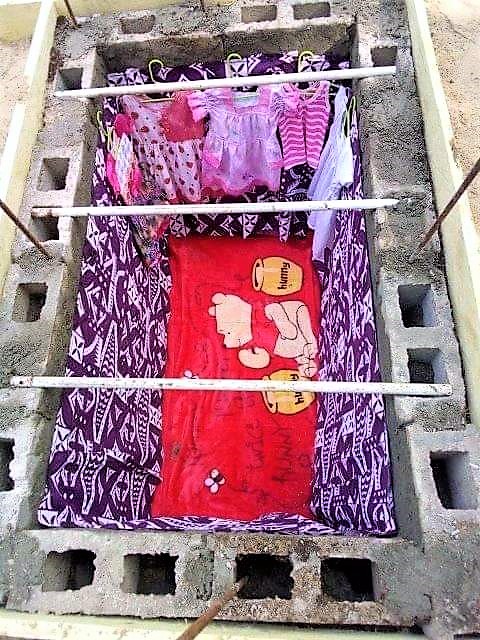
Undra’s decorated grave. Sent by my host papa.
Saima drops to her knees as Undra’s coffin is lowered into its new home.
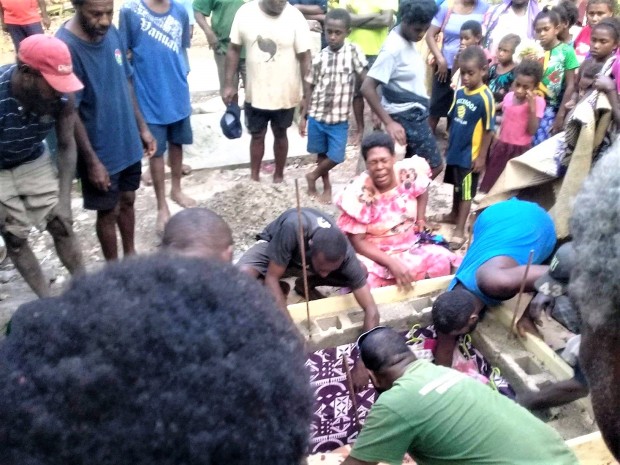
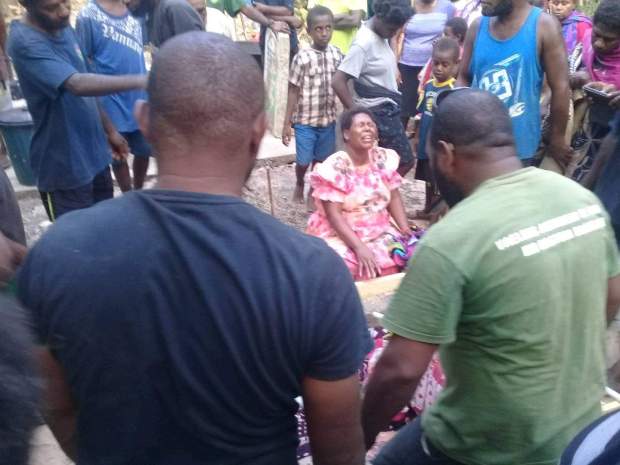

All three sent by my host papa.
I can picture the Pastor reading passages from his tattered Bible as masses of people push together to get a closer look. They’re holding their phones above a sea of heads in the hopes of getting one final picture of the day’s tragic events. They will show these pictures to people who couldn’t be present at the funeral. They will text them to loved ones who live on different islands, or in my case, different countries. These pictures will forever remind them of the day that they lost another child far too soon.
I always thought it was strange, people fervently taking morbid photos of dead bodies in their coffins. Of graves and of funeral services. But that’s the beauty of discovering and sharing different cultures. You learn to find beauty in places you never thought to look.
I can picture the Pastor asking Undra’s family to come forward. Saima, Willy, Richard, Rinny, Doraline, Cina, Polan, Leipakoa, Lesley, and so many others grab a handful of soil. One by one, they allow the sandy ground to drain through their finger tips and land on top of the wooden coffin, creating a dull thud, thud, thud as each hand takes a turn.
The wailing intensifies yet again as the soil begins to engulf the tiny box. The grave-diggers take their shovels and finish the job. Scoop. Thud. Scoop. Thud. Saima sits and watches, taking in the final moments before her daughter is gone forever.
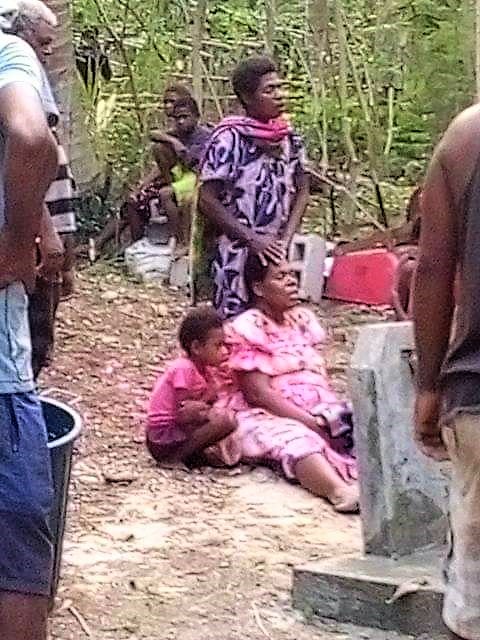
Winny and Linda comforting Saima. Sent by my host papa.
It doesn’t take long to fill the tiny grave. Soon enough, Undra is buried under a bed of freshly dug earth at 4:46pm On January 7th, 2020. The men will come back later to design and lay down her tombstone.
Finally, I can picture Saima and Willy lining up shoulder to shoulder with the rest of Undra’s family. Their heads are hung low, tears streaking their cheeks. The crowd lines up too, waiting to shake the hands of each of Undra’s family members. It is expected. One after another, the crowd moves forward, shaking hand after hand after hand. Some will wrap their arms around Saima’s neck, and they will cry into each others shoulders. Briefly, the crowd will slow to allow enough time for a sufficient embrace.
I can picture it perfectly. It is a beautiful, heartbreaking site. I may not be there, but in my own way, I am right there with them, and they are with me, always.
Rest in peace, little Undra.
